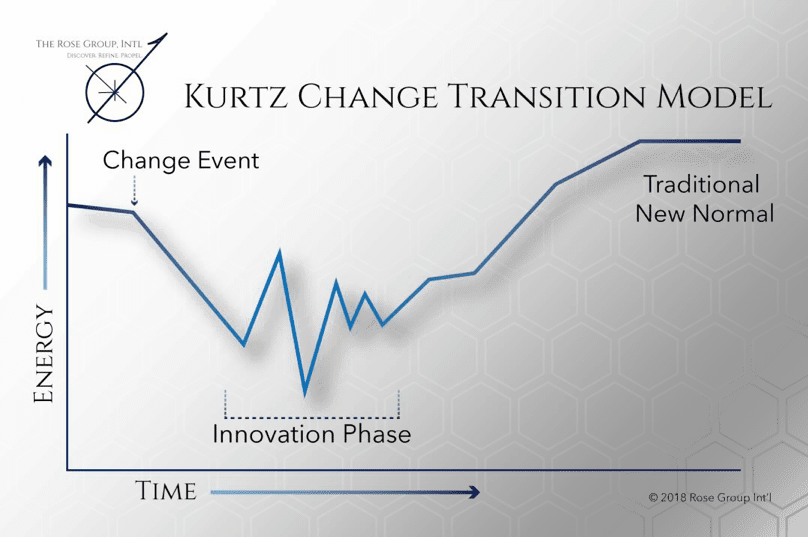As a leader, you’ve likely noticed that your team adapts to changes in the organization at different rates. Whether you’ve just implemented a new process or system or had a major reorganization, it can feel like wrangling cats and turtles all at the same time.
While the rate at which people normalize change differs, they each react in a predictable way.
Psychologists have been studying the U-shaped curve indicative of a transition for decades. However, that graph hasn’t been particularly valuable to organizations. That’s because it doesn’t show how change sparks innovation.
The changes leaders routinely make their teams “suffer through” are the very things that create highly engaged teams. Most leaders regularly throw away the opportunity to cultivate what they seek most in their people: creativity.
We created the Kurtz Change Transition Model as a tool for leadership to better understand how their team moves through transitions and to be able to use that knowledge to help them stay in an “innovation phase.”
The KCTM, pictured below, measures energy on the Y-axis and time on the X-axis.

You’ll notice that after people undergo a change, they enter an innovation phase. This is a tumultuous time when a person gathers as much information as possible to help shape a new normal, or, in other words, their new day-to-day experience. It is when we are the most creative, spontaneous and open to new possibilities. If you just went through a separation with a significant other, this is the stage where you would rent a new apartment you can barely afford and date a neon-light bender (it could happen, and did!) or travel the world because, well, why not? It’s when you move to a new state, start a new job and reinvent yourself. It’s that crazy wonderful first year of college.
Organizations want their people to be innovative, but they aren’t sure how to get them there exactly. Table tennis and beer in the fridge? Emotional safety? Big budgets? Nope. Innovation is born out of letting go of what was and looking toward many potential futures in a very real way.
Keeping your people in the intellectually creative space of an innovation phase means they will be willing to take on new things much easier, they will have more fun and they will be excited to keep pushing.
An exceptional leader must focus on the following five things to create a strong internal experience among people working in a long-term innovation phase.
1. Keep the end game in mind.
Keeping a team focused on the end game means communicating frequently. The innovation phase is chaotic, which will not be comfortable for many people. They will gain confidence if leadership continually refocuses them on the new normal. Be sure to look out for people who seek greater control, and ask them how they can help to guide others through the transition. Emphasize the way they are bringing order in some way to these chaotic situations.
2. Ensure time and space for emotional ups and downs.
The most challenging part of having a team perpetually live in an innovation phase is that compounding change events create wide swings between a positive and negative outlook. That’s because during this increase in creativity, there are a lot of ideas being generated. Some ideas will be great and other will be atrocious. On some days success seems impossible, and on other days success seems inevitable. Be ready to let these swings happen and to step in to actively manage them if necessary. When things go awry, reiterate the expectation that failure is progress.
3. Celebrate small victories.
Residing in a constant state of change means there are rarely big milestones to look forward to. Don’t be afraid to high-five in the hallway over smaller accomplishments.
4. Be on the lookout for change fatigue.
Change fatigue tends to crop up when the change seems arbitrary, unnecessary, unaligned or dissonant. It can also be the result of a lack of communication or a lack of involvement.
This is an exclusive excerpt from the authors’ new book, “iX Leadership: Create High-Five Cultures and Guide Transformation.”











